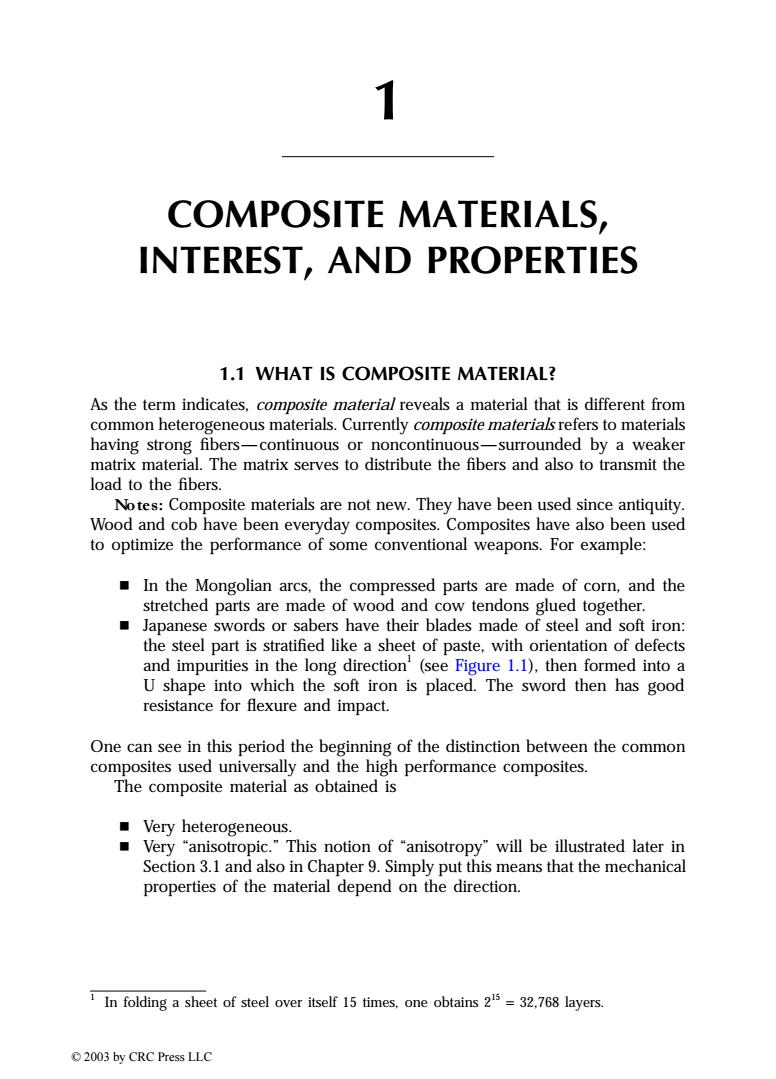正在加载图片...

COMPOSITE MATERIALS, INTEREST,AND PROPERTIES 1.1 WHAT IS COMPOSITE MATERIAL? As the term indicates,composite material reveals a material that is different from common heterogeneous materials.Currently composite materials refers to materials having strong fibers-continuous or noncontinuous-surrounded by a weaker matrix material.The matrix serves to distribute the fibers and also to transmit the load to the fibers. Notes:Composite materials are not new.They have been used since antiquity. Wood and cob have been everyday composites.Composites have also been used to optimize the performance of some conventional weapons.For example: In the Mongolian arcs,the compressed parts are made of corn,and the stretched parts are made of wood and cow tendons glued together. Japanese swords or sabers have their blades made of steel and soft iron: the steel part is stratified like a sheet of paste,with orientation of defects and impurities in the long direction'(see Figure 1.1),then formed into a U shape into which the soft iron is placed.The sword then has good resistance for flexure and impact. One can see in this period the beginning of the distinction between the common composites used universally and the high performance composites. The composite material as obtained is ■Very heterogeneous. Very "anisotropic."This notion of "anisotropy"will be illustrated later in Section 3.1 and also in Chapter 9.Simply put this means that the mechanical properties of the material depend on the direction. In folding a sheet of steel over itself 15 times,one obtains 2=32.768 layers. 2003 by CRC Press LLC1 COMPOSITE MATERIALS, INTEREST, AND PROPERTIES 1.1 WHAT IS COMPOSITE MATERIAL? As the term indicates, composite material reveals a material that is different from common heterogeneous materials. Currently composite materials refers to materials having strong fibers—continuous or noncontinuous—surrounded by a weaker matrix material. The matrix serves to distribute the fibers and also to transmit the load to the fibers. Notes: Composite materials are not new. They have been used since antiquity. Wood and cob have been everyday composites. Composites have also been used to optimize the performance of some conventional weapons. For example: In the Mongolian arcs, the compressed parts are made of corn, and the stretched parts are made of wood and cow tendons glued together. Japanese swords or sabers have their blades made of steel and soft iron: the steel part is stratified like a sheet of paste, with orientation of defects and impurities in the long direction1 (see Figure 1.1), then formed into a U shape into which the soft iron is placed. The sword then has good resistance for flexure and impact. One can see in this period the beginning of the distinction between the common composites used universally and the high performance composites. The composite material as obtained is Very heterogeneous. Very “anisotropic.” This notion of “anisotropy” will be illustrated later in Section 3.1 and also in Chapter 9. Simply put this means that the mechanical properties of the material depend on the direction. 1 In folding a sheet of steel over itself 15 times, one obtains 215 = 32,768 layers. TX846_Frame_C01 Page 3 Monday, November 18, 2002 10:34 AM © 2003 by CRC Press LLC